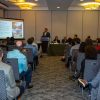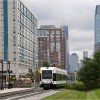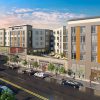Transit-Oriented Development
Transit-oriented development, or TOD, is generally defined as mixed-use residential and commercial development that is designed to take advantage of access to public transportation. TOD is an important component of smart growth because it allows people to live, work and play without having to rely on a car. TOD also allows the state to grow in a way that takes advantage of existing infrastructure and does not consume our limited open space.
Elements of good transit-oriented development include pedestrian-friendly design, a mix of compatible uses, connectivity to the surrounding community and a mix of housing options. New Jersey Future supports the expansion of TOD near New Jersey’s transit stations, and encourages municipalities to enact zoning that allows such development to occur.

Simple, small-scale transportation features make a community a safer, healthier, and more affordable place to get around. In a community that values street safety, crosswalks are clearly marked and strategically placed to ensure easy and safe passage for pedestrians.

New Jersey’s transit towns are experiencing something of a revival in the last decade and a half. This is an important positive development, since transit-oriented development (TOD) advances multiple societal goals.

Transit-friendly planning is a proactive, transit-focused approach developed by NJ Transit that is applicable to any community. Transit-friendly planning and transit-oriented development (TOD) are important components of smart growth because they allow people to live, work and play without having to rely on a car.

Despite being the most densely populated state in the country with over 150 train station towns, New Jersey is not a safe place for pedestrians of any age. In our effort to reduce car dependency, increase pedestrian safety, and encourage placemaking that serves the public, NJ ended 2022 with several announcements designating funds for advancing pedestrian and bicycle safety and transit-oriented development (TOD), indicating that the administration recognizes the importance of creating and fostering transportation options besides driving.

State leaders are embracing the concept of transit-oriented development (TOD), which encourages residential and commercial development to locate within walking distance of public transit stations, enabling residents to complete some or all of their trips without a car. The private sector also recognizes the demand for housing in transit-accessible towns. But with transit-adjacent neighborhoods being a limited commodity, how do we make sure the option of living near transit is available to everyone? The Ensuring Equity in Transit-Oriented Development session examined population patterns with respect to race and income around New Jersey’s transit stations.

An analysis of household income distributions in the neighborhoods around New Jersey’s transit stations shows that not all station areas offer the benefits of transit access across all income levels. June 2015.

The Economic Opportunity Act of 2013 included additional incentives for projects destined for “smart-growth” areas. This report analyzes how effective the updated incentives have been at directing growth to those areas. December 2014.

2016 Smart Growth Awards: The F. Berg Hat Factory Complex in Orange will be redeveloped into residences and artists spaces, and will serve as an anchor to the Valley Arts District.

New Jersey has 243 transit facilities, ranging from small single-track stations to major multi-line hubs. The unique characteristics of each station, of its immediate neighborhood, and of its surrounding municipality mean that a wide variety of development strategies should be brought to bear in order to maximize each location’s potential. This report shows how data assembled by New Jersey Future can be used to make decisions on how to target various kinds of transit-oriented development efforts. September 2012.

2016 Smart Growth Awards: A new multi-use building comprising retail, rental apartments and a parking garage, will bring an influx of new residents near Bloomfield’s train station.
See all New Jersey Future Blog posts and articles in this category »
Reports, Presentations and Testimony
- 07/15/2019: Comments on Draft Energy Master Plan
- 02/11/2019: Testimony on Economic Development Incentives
- Trenton Transit Center Strategic Action Blueprint July 2018
- 09/20/2018: Clean and Reliable Transportation Comments
- New Jersey Future Demographic Trends by Age September 2017
- New-Jersey-Future-Assessment-of-the-NJLIHTC-program
- New Jersey Future 2017 Gubernatorial Platform
- New Jersey Future Housing Affordability and Aging-Friendly Communities
- Housing Affordability and Aging-Friendly Communities Housing Cost-Burden Municipal Data by Municipality
- Housing Affordability and Aging-Friendly Communities Housing Cost-Burden Municipal Data by Cost Burden Rank
- Economic-Opportunity-Act-and-Smart-Growth-Progress-Report
- Creating Great Places To Age in New Jersey
- Creating Places To Age in New Jersey Municipal Best Practices
- Creating Places To Age in New Jersey municipal data
- Targeting Transit -- New Jersey Future
- 05-2009 Smart Housing Incentives Act - Summary
- NJ Transit RFQ for Parking Concession 10-10
- Transit-Oriented Development Workshop for HCDNNJ memb mtg 06-15-2011
- A Citizen's Guide to Transit-Oriented Development











